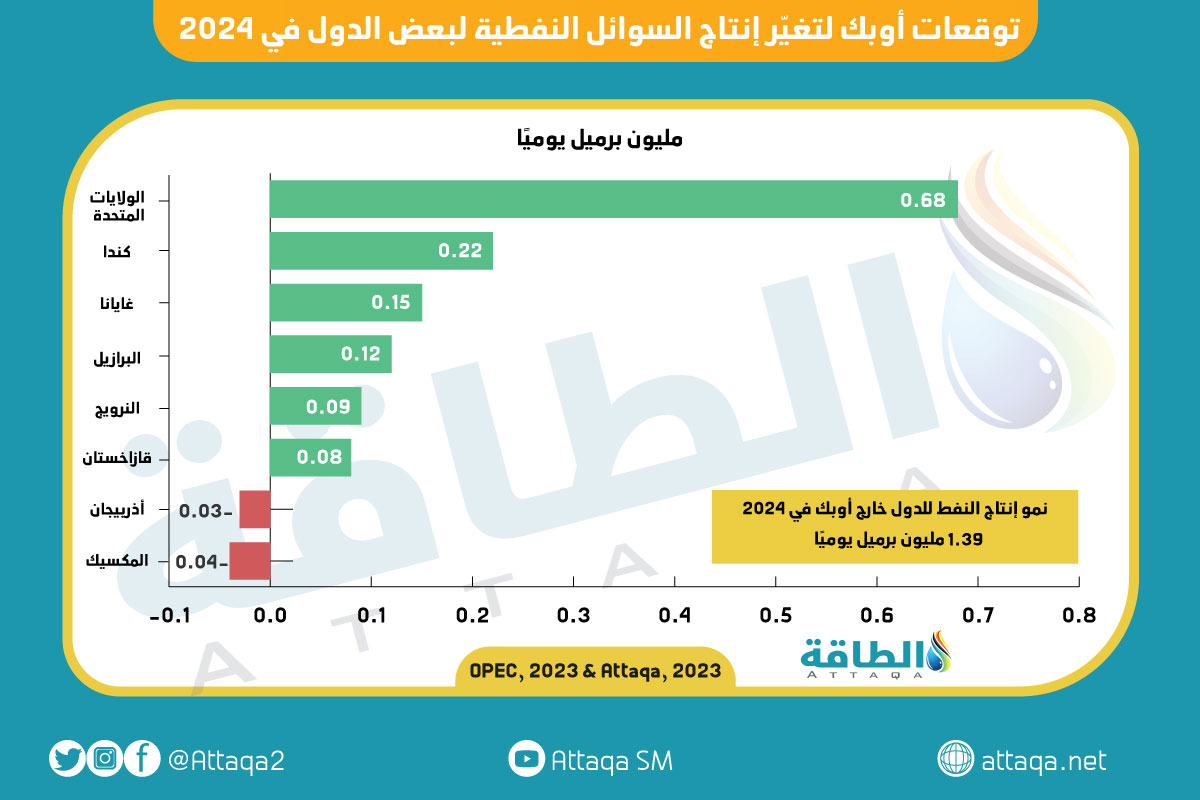Read this article
- Global oil demand growth is expected to slow next year
- OPEC’s estimates for 2024 are more optimistic than those of the Energy Information Administration and the Energy Information Administration
- Estimates of slowdown in non-OPEC oil supply growth in 2024
- The Energy Agency cuts oil demand estimates for the first time in 2023
- Oil stocks rose in the Organization for Economic Co-operation and Development in May
The International Energy Agency, the U.S. Energy Information Administration and OPEC have agreed on a slowdown in oil demand growth through 2024, but with a clear difference in the pace of increase on an annual basis, according to an analysis by the Energy Research Division of Vision. 3 large companies.
The newly released monthly reports of the 3 major companies for July 2023 showed growth in non-OPEC oil supply in the coming year, as major producers outside the OPEC+ alliance seek to meet cuts planned by the alliance, but at a slower pace than the current year (2023) estimate.
In 2023, the International Energy Agency cut its forecast for oil demand growth for the first time this year, while the Energy Information Administration and OPEC have shown higher-than-expected growth in China’s consumption in recent months. to Energy Research Division.
Oil demand projections to 2024
can be expected International Energy Agency Total global oil demand is projected to increase to 103.2 million barrels per day in 2024, with China accounting for 16.8 million, up from 16.2 million in 2023.
The Energy Agency raised its expectations that global oil consumption will increase by about 300,000 barrels per day over the next year, bringing demand up by 1.15 million barrels per day to a total of 103.2 million.
This means a slowdown in oil demand growth compared to the expected pace for the current year, even after it is cut by 220,000 barrels per day, which could reach 2.2 million barrels per day due to economic interventions, the energy agency indicated. Its monthly report.
The U.S. Energy Information Administration cut its estimates for oil demand growth in 2024 to 1.64 million barrels per day, down from a previous estimate of 1.70 million barrels per day, pushing the total to 102.80 million barrels per day.
This year, the Energy Information Administration estimates oil demand growth of 1.76 million barrels per day, an upward revision from the previous estimate of 1.59 million barrels per day.
The following graphic – produced by the Energy Research Division – tracks expectations for oil demand growth in major economies through 2024, according to OPEC:
In its first estimate for next year, OPEC expects oil demand to rise by 2.25 million barrels per day to a new record high of 104.25 million barrels per day, attributed to strong global economic growth coupled with China’s continued recovery. Action after recovery from corona virus.
OPEC expects oil demand in China to grow to 16.35 million bpd in 2024, up from 15.77 million bpd this year.
In 2023, OPEC raised its forecast for global demand growth to 2.44 million bpd, up 90,000 bpd from the June 2023 report forecast.
World oil supply
The International Energy Agency expects non-OPEC oil supplies to increase by 1.18 million barrels per day over the next year, to 68.51 million barrels per day.
The increase would be the same as expected in global oil supply, which would push it to a new record of 102.8 million barrels per day, with all the growth coming from countries outside the OPEC+ alliance.
It comes in light of the OPEC+ alliance’s agreement to extend its policy of cutting output by two million barrels a day until the end of next year, in addition to voluntary cuts by nine countries in the Saudi-led alliance. and Russia.
In 2023, the International Energy Agency expects non-OPEC oil supplies to increase by about 1.8 million barrels per day to 67.3 million, according to a report tracking the Energy Research Unit.
On the other hand, the US Energy Information Administration expects non-OPEC oil supply to increase by 0.96 million barrels per day next year, bringing the total to 68.62 million, a clear decrease from the current year’s (2023) growth estimates. 1.97 million barrels per day.
As for OPEC, estimates of the growth of oil supply from outside the organization were more optimistic, estimated at 1.39 million barrels per day, which is expected to reach a total of 68.53 million.
OPEC expects oil supplies from outside to increase by 1.41 million barrels per day this year, down slightly from last month’s estimate of 1.43 million.
The following graphic—produced by the Energy Research Division—reviews OPEC’s expectations for changes in oil-liquids production in some countries by 2024.:
Global oil stocks
Commercial oil stocks in OECD countries rose by 5.4 million barrels last May, bringing the total to 2.824 billion barrels, but they were about 92.2 million below the average over the past 5 years, according to the International Energy Agency’s monthly report.
The OPEC report showed that commercial oil stocks in the Organization for Economic Cooperation and Development increased by about 20.2 million barrels to reach 2.815 billion barrels in May 2023.
Global oil inventories were up 139 million barrels year-on-year, but about 101 million barrels lower than the 5-year average.
Total global oil stocks reached 2.838 billion barrels by the end of the second quarter of 2023, according to expectations from the US Energy Information Administration.
Related topics..
Also read this..

“Award-winning beer geek. Extreme coffeeaholic. Introvert. Avid travel specialist. Hipster-friendly communicator.”
